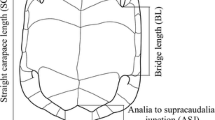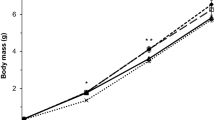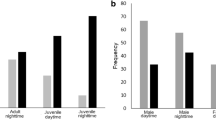Abstract
Ontogenetic changes in antipredator behavior optimize survival of growing animals. Leopard geckos (Eublepharis macularius) respond to a simulated predator either by postural and vocal threats, sometimes followed by biting, or alternatively by a rapid escape. The former “confrontational” and the latter “avoidance” behavior rarely occurs in a sequence; in fact, they represent mutually exclusive defensive strategies. We examined 552 individuals of a leopard gecko (E. macularius) of various ages, from hatching up to adulthood (31 months). Each experimental animal was exposed to a sequence of five “water-spraying” and ten “stick” (stick poking on base of the tail) stimuli, and the emitted behavior was recorded. We analyzed the effects of age, body size, body condition, adult–juvenile coloration, and sex on observed behavioral traits. The results showed that in the case of water-spraying stimulus, the usage of deterrent vocalization or escape tactic was affected by age and condition. In addition to that, using deterrent vocalization was influenced by the coloration of the animal. Stick stimulus evokes antipredator strategies that correspond with age and coloration (deterrent vocalization) and also with standardized body size (escape). Thus, leopard geckos exhibit clear ontogenetic change of defensive strategies, from threat–vocalization–bite strategy prevailing in juveniles to an escape strategy typical for adults. This behavioral change is accompanied by the ontogenetic switch of coloration from presumably warning contrasting light–dark banded pattern of juveniles to a cryptic spotted coloration of the adults.



Similar content being viewed by others
References
Amo L, López P, Martín J (2004) Wall lizards combine chemical and visual cues of ambush snake predators to avoid overestimating risk inside refugees. Anim Behav 67:647–653
Bateman PW, Fleming PA (2009) To cut a long tail short: a review of lizard caudal autotomy studies carried out over the last 20 years. J Zool 277:1–14
Bealor MT, Krekorian CO’N (2006) Chemosensory response of desert iguanas (Dipsosaurus dorsalis) to skin lipids from a lizard-eating snake (Lampropeltis getula californiae). Ethology 112:503–509
Bernard MF (2004) Predator-induced phenotypic plasticity in organisms with complex life. Ann Rev Ecol Evol Syst 35:651–673
Blomberg SP, Shine R (2000) Size-based predation by kookaburras (Dacelo novaeguineae) on lizards (Euamprus tympanum: Scincidae): what determines prey vulnerability. Behav Ecol Sociobiol 48:484–489
Blumstein DT, Munos O (2005) Individual, age and sex-specific information is contained in yellow-bellied marmot alarm calls. Anim Behav 69:353–361
Booth CL (1990) Evolutionary significance of ontogenetic colour change in animals. Biol J Linn Soc 40:125–163
Bragg WK, Fawcett JD, Bragg TB, Viets BE (2000) Nest-site selection in two eublepharid gecko species with temperature-dependent sex determination and one with genotypic sex determination. Biol J Linn Soc 69:319–332
Bull JJ, Gutzke WHN, Bulmer MG (1988) Nest choice in a captive lizard with temperature dependent sex determination. J Evol Biol 2:177–184
Caro T (2005) Antipredator defenses in birds and mammals. University of Chicago Press, Chicago
Castilla AM, Gosá A, Galán P, Pérez-Mellado V (1999) Green tails in lizards of the genus Podarcis: do they influence the intensity of predation? Herpetologica 55:530–537
Civantos E, Forsman A (2000) Determinants of survival in juvenile Psammodromus algirus lizards. Oecologia 124:64–72
Clark DR, Hall RJ (1970) Function of blue tail-coloration of the five-linked skink (Eumeces fasciatus). Herpetologica 26:271–274
Congdon JD, Vitt LJ, King WW (1974) Geckos: adaptive significance and energetics of tail autotomy. Science 184:1379–1380
Cooper WE (1994) Chemical discrimination by tongue flicking in lizards: a review with hypotheses on its origin and phylogenetic relationship. J Chem Ecol 20:439–487
Cooper WE (2008) Visual monitoring of predators: occurrence, cost and benefit for escape. Anim Behav 76:1365–1372
Cooper WE (2009) Fleeing and hiding under simultaneous risks and costs. Behav Ecol 20:665–671
Cooper WE, Frederick WG (2010) Predator lethality, optimal escape behaviour, and autotomy. Behav Ecol 21:91–96
Cooper WE, Sherbrooke WC (2010) Plesiomorphic escape decisions in cryptic horned lizards Phrynosoma having highly derived antipredatory defenses. Ethology 116:920–928
Cooper WE, Sherbrooke WC (2011) Crypsis influences escape decisions in the round-tailed horned lizard Phrynosoma modestusm. Can J Zool 88:1003–1010
Cooper WE, Vitt LJ (1985) Blue tails and autotomy: enhancement of predation avoidance in juvenile skink. Z Tierpsychol 70:265–276
Cott HB (1940) Adaptive coloration in animals. Methuen, London
Creer DA (2005) Correlations between ontogenetic change in color pattern and antipredator behaviour in the racer, Coluber contrictor. Ethology 111:287–300
Crews D, Groothuis T (2009) Tinergen’s four questions, ontogeny: sexual and individual differentiation. In: Bolhuis JJ, Verhulst S (eds) Tinbergen’s legacy: function and mechanism in behavioral biology. Cambridge University Press, UK, pp 54–81
Curio E (1993) Proximate and developmental aspects of antipredator behaviour. Adv Study Behav 22:135–238
Cuthill I, Stevens M, Sheppard J, Maddock T, Párraga CA, Troscianko TS (2005) Disruptive coloration and background pattern matching. Nature 434:73–74
Dial BE, Fitzpatrick LC (1981) The energetic costs of tail autotomy to reproduction in the lizard Coleonyx brevis (Sauria: Gekkonidae). Oecologia 51:310–317
Downes JS (2002) Does responsiveness to predator scents affect lizard survivorship? Behav Ecol Sociobiol 52:38–42
Eilam D (2005) Die hard: a blend of freezing and fleeing as a dynamic defence—implications for the control of defensive behaviour. Neurosci Biobehav Rev 29:1181–1191
Eskew EA, Willson JD, Winne CT (2009) Ambush site selection and ontogenetic shifts in foraging strategy in a semi-aquatic pit viper, the eastern cottonmouth. J Zool 277:179–186
Flores D, Tousignant A, Crews D (1994) Incubation temperature affects the behavior of adult leopard geckos (Eublepharis macularius). Physiol Behav 55:1067–1072
Frynta D, Frýdlová P, Hnízdo J, Šimková O, Cikánová V, Velenský P (2010) Ontogeny of sexual size dimorphism in monitor lizards: males grow for a longer period, but not at a faster rate. Zool Sci 27:917–923
Fuiman LA, Magurran AE (1994) Development of predator defences in fishes. Rev Fish Biol Fish 4:145–183
Fuller OP, Higham TE, Clark AJ (2011) Posture, speed, and habitat structure: three-dimensional hindlimb kinematics of two species of padless geckos. Zoology 114:104–112
Garland T (1985) Ontogenetic and individual variation in size, shape and speed in the Australian agamid lizard Amphibolurus nuchlis. J Zool 207:425–439
Gauthier C, Lesbarrères D (2010) Growth rate variation in captive species: the case of leopard geckos, Eublepharis macularius. Herpetol Conserv Biol 5:449–455
Hanson MT, Coss RG (2001) Age differences in the response of California ground squirrels (Spermophilus beecheyi) to conspecific alarm calls. Ethology 107:259–275
Hawlena D (2009) Colorful tails fade when lizards adopt less risky behaviors. Behav Ecol Sociobiol 64:205–213
Hawlena D, Boochnik R, Abramsky Z, Bouskila A (2006) Blue tail and striped body: why do lizards change their infant costume when growing up. Behav Ecol 17:889–896
Head ML, Keogh JS, Doughty P (2002) Experimental evidence of an age-specific shift in chemical detection of predators in a lizard. J Chem Ecol 28:541–554
Hertz PE, Huey RB, Nevo E (1982) Fight versus flight: body temperature influences defensive responses of lizards. Anim Behav 30:676–679
Hertzog HA Jr, Burghardt GM (1986) Development of antipredator responses in snakes: I. Defensive and open-field behaviors in newborns and adults of three species of garter snakes (Thamnophis melanogaster, T. sirtalis, T. butleri). J Comp Psychol 100:372–379
Higham TE, Russell AP (2010) Flip, flop and fly: modulated motor control and highly variable movement patterns of autotomized gecko tails. Biol Lett 6:70–73
Hogan JA, Bolhuis JJ (2009) Tinergen’s four questions and contemporary behavioural biology. In: Bolhuis JJ, Verhulst S (eds) Tinbergen’s legacy: function and mechanism in behavioral biology. Cambridge University Press, UK, pp 25–35
Hollén LI, Clutton-Brock T, Manser MB (2008) Ontogenetic changes in alarm-call production and usage in meerkats (Suricata suricatta): adaptations or constraints?. Behav Ecol Sociobiol 62:821–829
Hollén LI, Manser MB (2006) Ontogeny of alarm call responses in meerkats (Suricata suricata): the roles of age, sex, and nearby conspecifics. Anim Behav 72:1345–1353
Hollén LI, Randford AN (2009) The development of alarm call behaviour in mammals and birds. Anim Behav 78:791–800
Huey RB, Hertz PE (1982) Effects of body size and slope on sprint speed of a lizard (Stellio (Agama) stellio). J Exp Biol 97:401–409
Huey RB, Pianka ER (1977) Natural selection for juvenile lizards mimicking noxious beetles. Science 195:201–203
Irchick DJ (2000) Effects of behaviour and ontogeny on locomotor performance of a West Indian lizard, Anolis lineatopus. Funct Ecol 14:438–444
Janzen FJ, Tucker JK, Paukstis GL (2000) Experimental analysis of an early life-history stage: avian predation selects for larger body size of hatchling turtles. J Evol Biol 13:947–954
Keren-Rotem T, Bouskila A, Geffen E (2006) Ontogenetic habitat shift and risk of cannibalism in the common chameleon (Chamaeleo chamaeleon). Behav Ecol Sociobiol 59:723–731
Law BS (1991) Ontogenetic habitat shift in the eastern Australian water skink (Eulamprus quoyii)? Copeia 1991:1117–1120
Lind J, Cresswell W (2005) Determining the fitness consequences of antipredation behavior. Behav Ecol 16:945–956
Lind AJ, Welsh HH (1994) Ontogenic changes in foraging behavior and habitat use by the Oregon garter snake, Thamnophis atratus hydrophilus. Anim Behav 48:1261–1273
López P, Hawlena D, Polo V, Amo L, Martín J (2005) Sources of individual shy-bold variations in antipredator behaviour of male Iberian rock lizards. Anim Behav 69:1–9
Maginnis LT (2006) The costs of autotomy and regeneration in animals: a review and framework for future research. Behav Ecol 17:857–872
Magrath RD, Platzen D, Kondo J (2006) From nestling calls to fledgling silence: adaptive timing of change in response to aerial alarm calls. Proc R Soc Lond B 273:2335–2341
Marcelini D (1977) Acoustic and visual display behavior of gekkonid lizards. Am Zool 17:251–260
Marcelini DL, Jenssen TA (1991) Avoidance learning by the curly-tailed lizards, Leiocephalus schreibersi: implication for anti-predator behaviour. J Herpetol 25:238–241
Martín J, López P (2003) Ontogenetic variation in antipredator behavior of Iberian rock lizards (Lacerta monticola): effects of body-size-dependent thermal-exchange rates and costs of refuge use. Can J Zool 81:1131–1137
McElroy EJ, Jockey KL, Reilly SM (2008) The correlated evolution of biomechanics, gait and foraging mode in lizards. J Exp Biol 211:1029–1040
Medill SA, Renard A, Larivière S (2011) Ontogeny of antipredator behaviour of striped skunks (Mephitis mephitis). Ethol Ecol Evol 23:41–48
Nelson JN, Thompson MB, Pledger S, Keal SN, Daugherty CH (2006) Performance of juvenile tuatara depends on age, clutch and incubation regime. J Herpetol 40:399–403
Paulissen MA (1988a) Ontogenetic and seasonal comparisons of daily activity patterns of the six-lined racerunner, Cnemidophorus sexlineatus (Sauria: Teiidae). Am Midl Nat 120:355–361
Paulissen MA (1988b) Ontogenetic and seasonal shifts in microhabitat use by the lizard Cnemidophorus sexlineatus. Copeia 1988:1021–1029
Pongracz P, Altbacker V (2000) Ontogeny of the responses of European rabbits (Oryctolagus cuniculus) to aerial and ground predators. Can J Zool 78:655–665
Pough HF (1976) Cryptic effects of crossbanded and ringed patterns of snakes. Copeia 1976:834–836
Pough HF (1977) Ontogenetic change in blood transport capacity and endurance in garter snakes (Thamnophis sirtalis). J Comp Physiol B 116:337–345
Pough HF (1978) Ontogenetic changes in endurance in water snakes (Natrix sipedon): physiological correlates and ecological consequences. Copeia 1978:69–75
R Development Core Team (2010) R: a language and environment for statistical computing. R Foundation for Statistical Computing, Vienna
Roth ED, Johnson JA (2004) Size-based variation in antipredator behavior within a snake (Agkistrodon piscivorus) population. Behav Ecol 15:365–370
Ruxton GD, Sherratt TN, Speed MP (2004) Avoiding attack. Oxford University Press, Oxford
Sakata JT, Crews D (2004) Developmental sculpting of social phenotype and plasticity. Neurosci Biobehav Rev 28:95–112
Seufer H, Kaverkin H, Kirschner A (2005) The eyelash geckos. Kirschner & Seufer, Karlsruhe
Sherbrooke WC (2008) Antipredator responses by Texas horned lizards to two snake taxa with different foraging and subjugation strategies. J Herpetol 42:145–152
Shine R, Olsson MM, Lemaster MP, Moore IT, Mason RT (2000) Effects of sex, body size, temperature, and location on the antipredator tactics of free-ranging gartersnakes (Thamnophis sirtalis, Colubridae). Behav Ecol 11:239–245
StatSoft, Inc (2001) STATISTICA for Windows [Computer program manual]. StatSoft, Tulsa, http://www.statsoft.com
Thayer GH (1909) Concealing-coloration in the animal kingdom: an exposition of the laws of disguise through color and pattern: being a summary of Abbott H. Thayer’s discoveries. Macmillan, New York
Tinbergen (1963) On aims and methods of ethology. Z Tierpsychol 20:410–433
Tousignant A, Viets BE, Flores D, Crews D (1995) Ontogenetic and social factors affect the endocrinology and timing of reproduction in the female leopard gecko (Eublepharis macularius). Horm Behav 29:141–153
Treves A (2000) Theory and method in studies of vigilance and aggregation. Anim Behav 60:711–722
Välimäki K, Herczeg G (2012) Ontogenetic and evolutionary effects of predation and competition on nine-spined stickleback. J Anim Ecol 81:859–867
Viets BE, Tousignant A, Ewert MA, Nelson CE, Crews D (1993) Temperature-dependent sex determination in the leopard gecko, Eublepharis macularius. J Exp Zool 265:679–683
Wilson D, Heinsohn R, Endler A (2007) The adaptive significance of ontogenetic colour change in tropical python. Biol Lett 3:40–43
Acknowledgments
The research was supported by the Grant Agency of the Academy of Sciences of the Czech Republic project no. IAA 601410803.
Conflict of interest
The authors declare that they have no conflict of interest.
Ethical standards
All performed experiments were allowed by Ethical Committee of the Charles University in Prague, Czech Republic and approved by Ethical Committee of Ministry of Education, Youth and Sports, license no. 27667/2007-30.
Author information
Authors and Affiliations
Corresponding author
Additional information
Communicated by S. J. Downes
Electronic supplementary material
Below is the link to the electronic supplementary material.
A young Leopard gecko (5 months) possessing the sub-adult color pattern is exposed to the water-spraying stimulus (five times). The response of the gecko to the stimulus is a defensive posture. (MPG 1788 kb)
A young animal (5 months) possessing the subadult color pattern is exposed to the stick stimulus (ten times).The response of the gecko are various defensive postures accompanied by a threat vocalization. (MPG 4727 kb)
An adult 29-month-old leopard gecko is trying to localize the water-spraying stimulus and to face the potential threat. (MPG 2169 kb)
An adult 29-month-old leopard gecko exhibits various defensive postures in response to the stick stimulus (five times). (MPG 4775 kb)
An adult 29-month-old leopard gecko performs the escape behavior in response to the touching stick. (MPG 5033 kb)
Rights and permissions
About this article
Cite this article
Landová, E., Jančúchová-Lásková, J., Musilová, V. et al. Ontogenetic switch between alternative antipredatory strategies in the leopard gecko (Eublepharis macularius): defensive threat versus escape. Behav Ecol Sociobiol 67, 1113–1122 (2013). https://doi.org/10.1007/s00265-013-1536-3
Received:
Revised:
Accepted:
Published:
Issue Date:
DOI: https://doi.org/10.1007/s00265-013-1536-3




